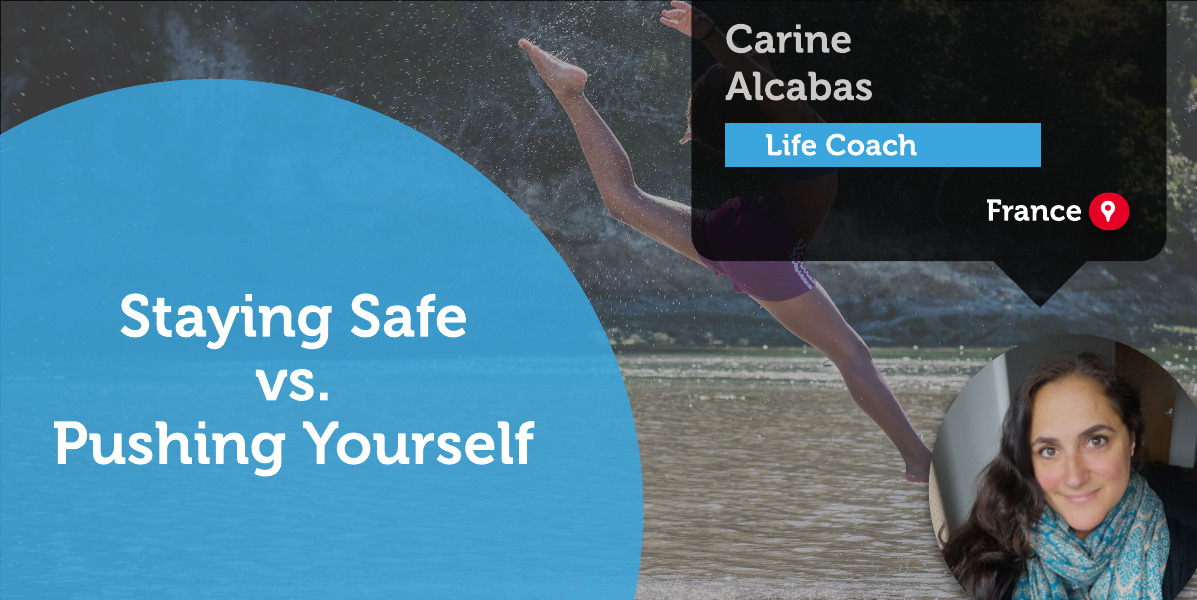A Coaching Power Tool By Carine Alcabas, Life Coach, FRANCE

The Benefits Of Staying Safe vs. Pushing Yourself
People are usually scared of the unknown. The idea of doing something new, moving to a new place, changing jobs, having more responsibilities, meeting new people, becoming parents, buying a house, etc. All of these can lead to apprehension, questioning, and fear.
It is much easier to stay in our « comfort zone », to stay put and stick to our same old habits, knowing exactly what to expect from tomorrow. On another hand, how exciting can your life be if you stay in this comfort zone, without ever questioning it, without curiosity or any dreams in your life? Our ever so reassuring and comfortable routines can also turn out to be very demotivating.
When I was working as a Training coordinator a few years ago, I was happy in my job, going to work every day, organizing events, meeting a lot of people. When my evaluation arrived, they told me they were very happy, that I was doing a great job, but that I was staying ‘in my comfort zone too much. My first reaction was frustration, I did not understand and took it the wrong way. Then I realized that they believed in me and knew that I was capable of « more ».
So what is holding us back from « doing more »? Why is it easier to stay safe than to push ourselves?
Staying Safe vs. Pushing Yourself Meaning
What Does Staying Safe Mean:
- A term used as a friendly farewell, generally expressing carefulness for a person to not get into trouble of any sort (1)
- Something safe means that it does not cause physical harm or danger
- Free from danger
- Protect, care for, preserve, defend, conserve, maintain (2)
What Does Pushing Yourself Mean:
- Pushing yourself builds mental toughness. When you’re able to enter a situation where you feel uncomfortable and stay focused and present instead of feeling sorry for yourself and quitting, you become stronger and more confident
- Pushing yourself refers to accepting a challenge and undertaking it, despite its difficulty. Not pushing yourself is easy, comfortable, and reactionary – you just keep doing what you’ve been doing and go with the flow
- Exert yourself, make an effort. Put your all into something, try-hard, work flat out.
So, on one side we have security, preservation, protection and on the other side: challenges, efforts, difficulties.
Today, with the Covid pandemic, we are more likely to stay in our comfort zone, as we fear the present and fear the future, facing many changes in the way we’re living our lives (personal and professional) and uncertain of what the future will look like.
So, what can we do to make this fear disappear and take action to get our lives back?
We need to push and believe in ourselves!
Most people think about the day ahead, what they need to accomplish, and, focus more upon the future than the present moment. If all we see and hear is bad news and the future doesn’t look bright, it can affect our ability to stay focused and positive.
We need to change our perspective and adapt our perception of our daily lives, to get out of our comfort zone and be able to face the challenges and difficulties that will lead us to success.
The way I see it, if you want the rainbow, you gotta put up with the rain – Dolly Parton
Make a list of the Things You Are Eager to Staying Safe vs. Pushing Yourself
Make a list of the things you are eager to achieve in life, personal or professional project you have been dreaming of, but never even tried to do:
- What has come in the way of you doing it?
- When you have the plan, what will it give you that you don’t have now?
- How would you feel after having successfully done it?
- How would your life change?
How Successful People Achieve Their Goals
Without pushing yourself you will never know how far you can go and what you can achieve. This is how successful people achieve their goals, they will always strive for more and push to points of discomfort.
As coaches, we must acknowledge that our perceptions regarding staying safe and pushing ourselves can be different from our clients. The most important is to remain non-judgmental towards the client.
With this in mind, here are a few elements to use in a coaching session:
- Identify the client’s values
What is the client’s understanding of the issue they are facing? What is their underlying belief? What is the client’s experience with staying in their comfort zone?
- Use active listening and powerful questions
Always take the time to listen actively to your client, don’t rush to conclusions, try to understand what is hidden behind, using powerful questions:
- Address what they are afraid of
What has been holding you back? What have you tried to change? What could you do differently? What is important for you?
- Set goals and be accountable
What small step could you take? How will you hold yourself accountable?
- Make the client aware of their positive feelings
Seeing your issue from this new perspective, having set these goals, how are you feeling now? How would you feel after achieving these new goals?
Staying Safe vs. Pushing Yourself Lead Them to a Different Goal
Staying safe and pushing ourselves is both parts of our everyday life, and we need them at different times in our lives.
As a coach, being able to help our clients get out of their comfort zone is a difficult task.
We need to help the client to become aware that they can face the problem from a different perspective, which will lead them to a different goal and positive results.
References